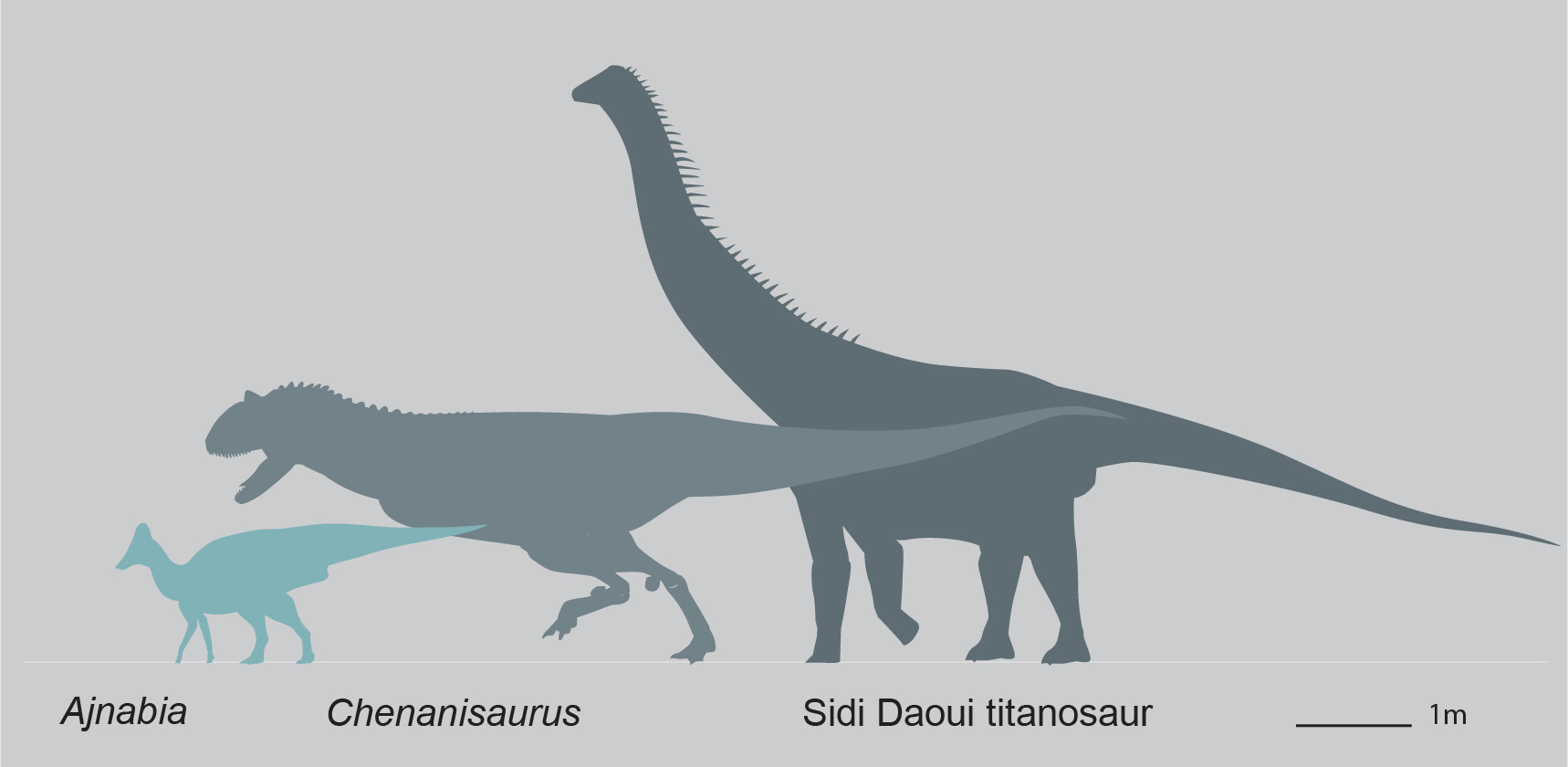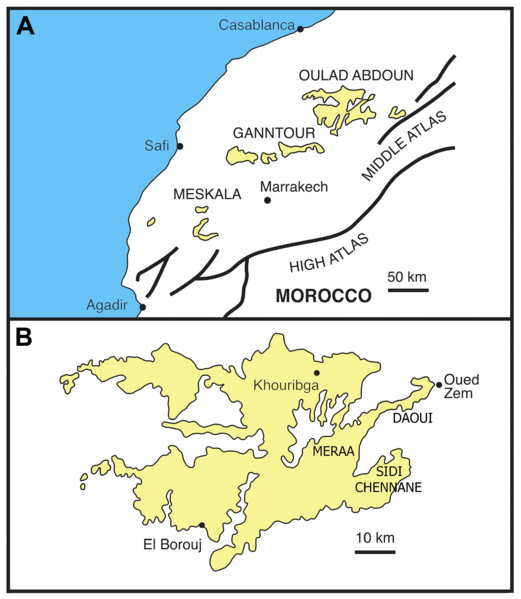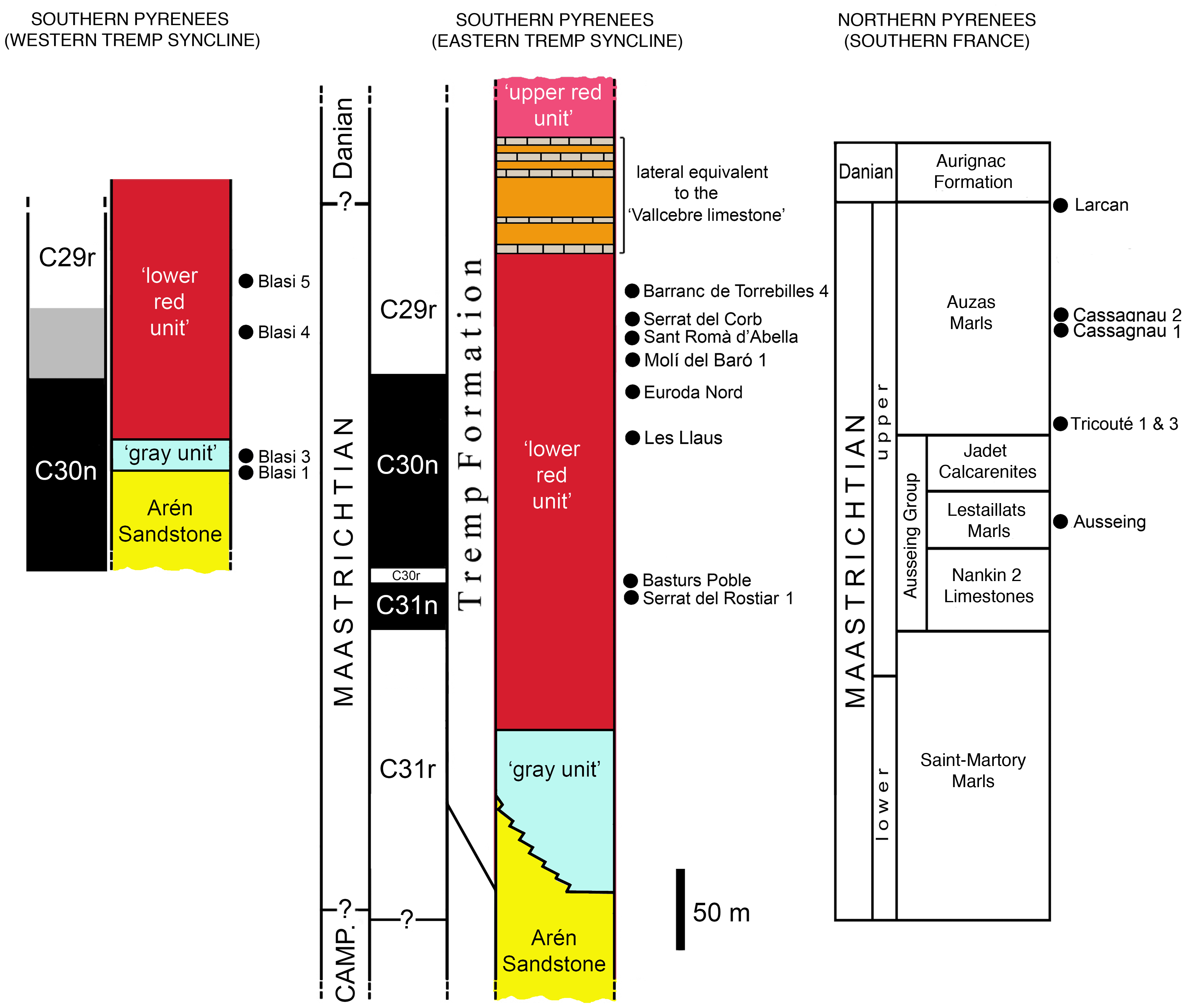|
Ajnabia
''Ajnabia'' (meaning "stranger" or "foreigner") is a genus of lambeosaurine hadrosaur from the Late Cretaceous (Maastrichtian) of Morocco. It is the first definitive hadrosaur from Africa, and is thought to be related to European dinosaurs like ''Arenysaurus''. The discovery of ''Ajnabia'' came as a surprise to the paleontologists who found it, because Africa was isolated by water from the rest of the world during the Cretaceous, such that hadrosaurs were assumed to have been unable to reach the continent. The animal is relatively small; assuming it represents an adult it would be one of the smallest if not the smallest known hadrosaurids. Discovery and naming Ajnabia was recovered from the Late Maastrichtian strata of the phosphate mines at Sidi Chennane, in Khouribga Province, Morocco. Recovered elements include most of the left maxilla and part of the right, and a fragment of the right dentary. The name Ajnabia derives from the Arabic ''ajnabi'', meaning "stranger" or "foreigne ... [...More Info...] [...Related Items...] OR: [Wikipedia] [Google] [Baidu] |
Arenysaurini
Arenysaurini is a proposed tribe of primitive lambeosaurine hadrosaurs. It is composed of genera found in Europe and North Africa during the end of the Cretaceous period, and has been suggested to unite all lambeosaurs from the former continent into a singular monophyletic group. Description Hadrosaurs were a group of herbivorous dinosaurs capable of walking on two or four legs, possessing beaks and complex batteries of teeth; members of Arenysaurini, being of the lambeosaurine lineage of Hadrosauridae, would have possessed large crests on their skulls made up of arrays of nasal passages. Multiple anatomical traits of the skull and teeth unite some or all potential members of Arenysaurini; a mixture of traits seen in primitive and derived lambeosaurs is observed. Examples of primitive traits include a short and a broad dorsal process (bony production) on the maxilla, reduced extensively in derived lambeosaurs. Additionally, several traits distinguish arenysaurs from other lambeos ... [...More Info...] [...Related Items...] OR: [Wikipedia] [Google] [Baidu] |
Ouled Abdoun Basin
The Oulad Abdoun Basin (also known as the Ouled Abdoun Basin or Khouribga Basin) is a phosphate sedimentary basin located in Morocco, near the city of Khouribga. It is the largest in Morocco, comprising 44% of Morocco's phosphate reserves, and at least 26.8 billion tons of phosphate. It is also known as an important site for vertebrate fossils, with deposits ranging from the Late Cretaceous (Cenomanian-Turonian) to the Eocene epoch (Ypresian), a period of about 25 million years. Geography The Oulad Abdoun is located west of the Atlas Mountains, near the city of Khouribga. The Oulad Abdoun phosphate deposits encompass some , an area of . The Oulad Abdoun is the largest and northernmost of Morocco's major phosphate basins, which from northeast to southwest, include the Ganntour, Meskala, and Oued Eddahab (Laayoune-Baa) basins. Paleobiota The Oulad Abdoun Basin stretches from late Cretaceous to the Eocene, and contains abundant marine vertebrate fossils, including sharks, bo ... [...More Info...] [...Related Items...] OR: [Wikipedia] [Google] [Baidu] |
Adynomosaurus
''Adynomosaurus'' is a genus of lambeosaurine dinosaur from the Late Cretaceous of what is now Catalonia, Spain. First discovered in 2012, it was named in 2019 with the type and only species ''Adynomosaurus arcanus'', as an addition to the very incomplete fossil record of hadrosaurides dinosaurs from the Late Cretaceous of Europe. It is only known from scant material, but is distinguished from other hadrosaurs by its weakly developed shoulder blade which would have had underdeveloped musculature, which lends it its scientific name, partially from the Greek word for "weak". Its exact relationships with other hadrosaurs remain unresolved, with it not consistently being recovered as a relative of any other specific genera, though some studies have allied it with Tsintaosaurini or even found it outside of Hadrosauridae. It would have lived as part of a diverse coastal estuaryweak ecosystem, made up of meandering rivers and mud flats, and fits into a picture of major ecological turnove ... [...More Info...] [...Related Items...] OR: [Wikipedia] [Google] [Baidu] |
Canardia
''Canardia'' is an extinct genus of lambeosaurine dinosaur known from the Late Cretaceous Marnes d'Auzas Formation (late Maastrichtian stage) of Haute-Garonne department, in Occitanie region, southwestern France. The type species ''Canardia garonnensis'' was first described and named by Albert Prieto-Márquez, Fabio M. Dalla Vecchia, Rodrigo Gaete and Àngel Galobart in 2013. It is only known from juvenile specimens. The name of the genus comes from “canard”, the French word for “duck”, an allusion to the fact that this animal belongs to the hadrosaurids which are also known as duck-billed dinosaurs. The specific epithet ''garonnensis'' refers to the Haute-Garonne department where this dinosaur has been found. Although universally recognized as a lambeosaurine, its precise position within them is debated. Some authors consider it as a close relative of the genus ''Aralosaurus'' from Central Asia with which it would form the tribe Aralosaurini, while others include it in a m ... [...More Info...] [...Related Items...] OR: [Wikipedia] [Google] [Baidu] |
Pararhabdodon
''Pararhabdodon'' (meaning "near fluted tooth" in reference to ''Rhabdodon'') is a genus of tsintaosaurin hadrosaurid dinosaur, from the Maastrichtian-age Upper Cretaceous Tremp Group of Spain. The first remains were discovered from the Sant Romà d’Abella fossil locality and assigned to the genus ''Rhabdodon'', and later named as the distinct species ''Pararhabdodon isonensis'' in 1993. Known material includes assorted postcranial remains, mostly vertebrae, as well as from the skull. Specimens from other sites, including remains from France, a maxilla previously considered the distinct taxon ''Koutalisaurus kohlerorum'', an additional maxilla from another locality, the material assigned to the genera ''Blasisaurus'' and ''Arenysaurus'', and the extensive Basturs Poble bonebed have been considered at different times to belong to the species, but all of these assignments have more recently been questioned. It was one of the last non-avian dinosaurs known from the fossil record th ... [...More Info...] [...Related Items...] OR: [Wikipedia] [Google] [Baidu] |
Koutalisaurus
''Koutalisaurus'' (meaning "spoon lizard", in reference to the shape of the dentary) is a potentially dubious genus of extinct hadrosaurid dinosaur from the Arenysaurini. It is based on a mostly complete dentary from the Maastrichtian-age Upper Cretaceous Tremp Formation near the town of Abella de la Conca, Lleida, Spain. Discovery and naming The holotype dentary, IPS SRA 27, had previously been referred to ''Pararhabdodon'' in 1999,Casanovas, M.L, Pereda-Suberbiola, X., Santafé, J.V., and Weishampel, D.B. (1999). First lambeosaurine hadrosaurid from Europe: palaeobiogeographical implications. ''Geological Magazine'' 136(2):205-211. but comes from a different locality, is based on non-comparable material, and has unusual characteristics, leading Prieto-Marquez ''et al.'' (2006) to place the dentary in the new species ''Koutalisaurus kohleorum''.Prieto-Marquez, A., Gaete, R., Rivas, G., Galobart, Á., and Boada, M. (2006). Hadrosauroid dinosaurs from the Late Cretaceous of Spain ... [...More Info...] [...Related Items...] OR: [Wikipedia] [Google] [Baidu] |
Chenanisaurus Barbaricus
''Chenanisaurus'' is a genus of predatory abelisaurid dinosaur, with a single known species ''C. barbaricus''. It comes from the upper Maastrichtian phosphates of the Ouled Abdoun Basin in Morocco, North Africa. The animal is known from a holotype, consisting of a partial jaw bone, and several isolated teeth found in the same beds. ''Chenanisaurus'' is one of the largest members of the Abelisauridae, and one of the last, being a contemporary of the North American ''Tyrannosaurus''. It would have been among the dinosaur species wiped out by the Chicxulub asteroid impact and the Cretaceous-Paleogene mass extinction that followed. Description ''Chenanisaurus'' is quite a large abelisaurid, measuring , based on measurements of the holotype dentary. Its size is comparable to that of large abelisaurids such as '' Carnotaurus'' and '' Pycnonemosaurus''. Nicholas R. Longrich and colleagues, the describers of ''Chenanisaurus'', identified distinctive features distinguishing the ... [...More Info...] [...Related Items...] OR: [Wikipedia] [Google] [Baidu] |
Hadrosaur
Hadrosaurids (), or duck-billed dinosaurs, are members of the ornithischian family Hadrosauridae. This group is known as the duck-billed dinosaurs for the flat duck-bill appearance of the bones in their snouts. The ornithopod family, which includes genera such as ''Edmontosaurus'' and ''Parasaurolophus'', was a common group of herbivores during the Late Cretaceous Period. Hadrosaurids are descendants of the Upper Jurassic/Lower Cretaceous iguanodontian dinosaurs and had a similar body layout. Hadrosaurs were among the most dominant herbivores during the Late Cretaceous in Asia and North America, and during the close of the Cretaceous several lineages dispersed into Europe, Africa, South America and Antarctica. Like other ornithischians, hadrosaurids had a predentary bone and a pubic bone which was positioned backwards in the pelvis. Unlike more primitive iguanodonts, the teeth of hadrosaurids are stacked into complex structures known as dental batteries, which acted as effective g ... [...More Info...] [...Related Items...] OR: [Wikipedia] [Google] [Baidu] |
Chicxulub Impact
The Chicxulub crater () is an impact crater buried underneath the Yucatán Peninsula in Mexico. Its center is offshore near the community of Chicxulub, after which it is named. It was formed slightly over 66 million years ago when a large asteroid, about in diameter, struck Earth. The crater is estimated to be in diameter and in depth. It is the second largest confirmed impact structure on Earth, and the only one whose peak ring is intact and directly accessible for scientific research. The crater was discovered by Antonio Camargo and Glen Penfield, geophysicists who had been looking for petroleum in the Yucatán Peninsula during the late 1970s. Penfield was initially unable to obtain evidence that the geological feature was a crater and gave up his search. Later, through contact with Alan R. Hildebrand in 1990, Penfield obtained samples that suggested it was an impact feature. Evidence for the crater's impact origin includes shocked quartz, a gravity anomaly, and tektit ... [...More Info...] [...Related Items...] OR: [Wikipedia] [Google] [Baidu] |
Lambeosaurinae
Lambeosaurinae is a group of crested hadrosaurid dinosaurs. Classification Lambeosaurines have been traditionally split into the tribes or clades Parasaurolophini (''Parasaurolophus'', ''Charonosaurus'', others (?).) and Lambeosaurini (''Corythosaurus'', ''Hypacrosaurus'', ''Lambeosaurus'', others.). Corythosaurini (synonym of Lambeosaurini, see below) and Parasaurolophini as terms entered the formal literature in Evans and Reisz's 2007 redescription of ''Lambeosaurus magnicristatus''. Corythosaurini was defined as all taxa more closely related to ''Corythosaurus casuarius'' than to ''Parasaurolophus walkeri'', and Parasaurolophini as all those taxa closer to ''P. walkeri'' than to ''C. casuarius''. In this study, ''Charonosaurus'' and ''Parasaurolophus'' are parasaurolophins, and ''Corythosaurus'', ''Hypacrosaurus'', ''Lambeosaurus'', ''Nipponosaurus'', and ''Olorotitan'' are corythosaurins. However, later researchers pointed out that due to the rules of priority set forth b ... [...More Info...] [...Related Items...] OR: [Wikipedia] [Google] [Baidu] |
Maastrichtian
The Maastrichtian () is, in the ICS geologic timescale, the latest age (uppermost stage) of the Late Cretaceous Epoch or Upper Cretaceous Series, the Cretaceous Period or System, and of the Mesozoic Era or Erathem. It spanned the interval from . The Maastrichtian was preceded by the Campanian and succeeded by the Danian (part of the Paleogene and Paleocene). The Cretaceous–Paleogene extinction event (formerly known as the Cretaceous–Tertiary extinction event) occurred at the end of this age. In this mass extinction, many commonly recognized groups such as non-avian dinosaurs, plesiosaurs and mosasaurs, as well as many other lesser-known groups, died out. The cause of the extinction is most commonly linked to an asteroid about wide colliding with Earth, ending the Cretaceous. Stratigraphic definitions Definition The Maastrichtian was introduced into scientific literature by Belgian geologist André Hubert Dumont in 1849, after studying rock strata of the Chalk Group c ... [...More Info...] [...Related Items...] OR: [Wikipedia] [Google] [Baidu] |
Cretaceous Morocco
The Cretaceous ( ) is a geological period that lasted from about 145 to 66 million years ago (Mya). It is the third and final period of the Mesozoic Era, as well as the longest. At around 79 million years, it is the longest geological period of the entire Phanerozoic. The name is derived from the Latin ''creta'', "chalk", which is abundant in the latter half of the period. It is usually abbreviated K, for its German translation ''Kreide''. The Cretaceous was a period with a relatively warm climate, resulting in high eustatic sea levels that created numerous shallow inland seas. These oceans and seas were populated with now- extinct marine reptiles, ammonites, and rudists, while dinosaurs continued to dominate on land. The world was ice free, and forests extended to the poles. During this time, new groups of mammals and birds appeared. During the Early Cretaceous, flowering plants appeared and began to rapidly diversify, becoming the dominant group of plants across the Earth b ... [...More Info...] [...Related Items...] OR: [Wikipedia] [Google] [Baidu] |










